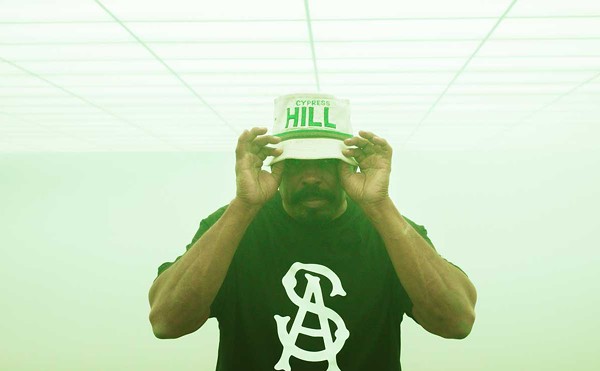’Tis the season to appease the sound hounds on your lists with large servings of music. We suggest four collections with music from two centuries.
His Name Is Alive
The Cloud Box
timestereo
Not long ago, the Livonia-based ensemble His Name Is Alive was unceremoniously let go by 4AD, the British label that had been its home for more than a dozen years. Resident linchpin Warren Defever and his ever-changing cast of collaborators had carved out what can only be described as their own world of pop music, sound experiment and textural expeditions guided only by the North Star in Defever’s noggin. The band’s last 4AD release was 2002’s Last Night — a continuation of Defever and singer Lovetta Pippin’s recent forays into a sultry, cosmic rhythm and blues. The end of the 4AD era for the band happened to coincide with Defever ramping up activity at his own Brown Rice studio in Detroit. Not that he was ever “fettered” by the constraints of his record label or anything, but the release of The Cloud Box (on Defever and pal Davin Brainard’s timestereo imprint) represents a clearing of the proverbial cache, a declaration of intent and evidence of Defever’s enthusiasm for continued exploration of his own left-of-center musical id. It’s an all-star revue featuring most of Defever’s cohorts — including members of Nomo, flashpapr and Ida, as well as Kevin Calloway, Eric Cook, Pippin, Karin Oliver and many others — not to mention, on the set’s 10th disc, sounds of an indeterminate number of Detroiters celebrating the Pistons’ NBA championship. From pop to minimal pulse, soundscape to gamelan jams, this 10-CD set (presented in handmade stencil-painted wood boxes, accompanied by an explanatory note printed on vellum for each CD) is a cloudburst of meditation and easily a year’s worth of transfixing listenings. In short, The Cloud Box is what happens when you give a hard-working, DIY, borderline-genius iconoclast his own studio and all the time in the world.
On the meditative end of the spectrum is the lovely USA vs. Gamelan (Disc 2) as Devefer, his wife Hitoko and Nomo’s Elliot Bergman “get the keys to the Gamelan” orchestra at the University of Michigan School of Music for an overnight recording session. The trio find lush, simple patterns and textures that ebb and flow from conscious attention to unconscious conjuring.
On The Pinecone (Disc 4) rustic, clicky and nervous abstractions include Track 3’s effervescent evocations of rail travel — far-off whistles and brakes squeal and insinuate themselves under a guitar rhythm that never quite chugs. Track 9 bubbles and clicks and grooves along in a manner most murkily funky.
Spring Can Really Hang You Up the Most (Disc 6) was drowned out by the audience in its earlier incarnation as a gallery sound installation. But here it asks only that you stretch out and wait as birds and nature noises flitter on top of a warm drone. (Full disclosure: This piece was created for a show curated by my wife.)
Dreem Up (Disc 3) started, we’re told, as an unfinished His Name Is Alive record with singer Karin Oliver laying down vocal tracks a cappella. Recently, Defever returned to the songs to lay down the music. The resulting virtual collaboration — and the soothing (if haunted) presence of Oliver’s voice — fits neatly into the band’s early 4AD discography. But the thing is, since Defever recorded the music years later, it benefits from his more recent, exceptionally disciplined approach. Where once tape manipulations and ear-candy gewgaws might have found their way into the mix, Dreem Up is marvelously focused in its 2 a.m.-rural musical and lyrical ruminations on identity and mystery.
Speaking of the band’s early days, Defever and company re-recorded four essential tracks of HNIA’s 1990 debut, Livonia, as a string piece (Disc 5). Defever is here joined by flashpapr’s Zach Wallace (upright bass) and Jake Danziger (violin) plus Ida’s Ida Pearle (violin).
Disc 9, Free Concert, is a neat summation of HNIA’s recent work. A free concert performed July 10, 2004, it features Pippin on vocals plus sax, piano, guitar and conga backing, and damned if it’s not a batch of pure sweaty, funky and unapologetically sexy (and therefore decidedly non-indie/cerebral) nightclub grooves.
Time and space constraints keep us from detailing what happens on Discs 1, 7, 8 and 10 … but you get the idea.
Call it a comeback. Call it a career retrospective. But, to be sure, his name is still alive. —Chris Handyside
Miles Davis
Seven Steps: The Complete Columbia Recordings of Miles Davis 1963-1964
Columbia
Is there another jazz documentation project on the scale of Columbia’s Miles Davis reissues? With this 10-CD box set filling in a gap, we now have seven vault-mining box sets covering Miles Davis’ work at the label from 1955 to 1970. And these are in addition to strictly live sets like the complete live-at-the-Blackhawk packages, live-at-the-Plugged Nickel, etc., and sundry other compilations.
This new (and largest) collection is a sort of extended making-of-the-band saga. For years before, Miles Davis had presided over incremental changes in his group — sidemen coming and going, but not the kind of wholesale turnover that begins this disc. In April and May 1963, Miles goes into the studio to record what becomes Seven Steps to Heaven with Ron Carter on bass, George Coleman on sax, Victor Feldman on piano and Frank Butler on drums. For his next studio session he cements what was arguably his greatest rhythm section — Carter, pianist Herbie Hancock and teenage drummer Tony Williams. Thereafter, Miles boycotted the studio for three years, but the live recordings reflect a band as it defines a new mix of finesse, freedom and fire. Coleman (judged a bit too smooth) eventually leaves, to be replaced briefly by Sam Rivers (judged a bit too rough) and finally Wayne Shorter (the Goldilocks solution). Concerts that were edited and shuffled into such discs as Miles Davis in Europe and Four & More are restored to their full lengths and original sequences. In the process, one of the marvels of modern music, Miles’ great late ’60s quintet comes into focus. That band’s studio triumphs are — you guessed it — a story for another box-set, The Complete Studio Recordings of the Miles Davis Quintet (1965-1968). —W. Kim Heron
Bert Williams
Bert Williams: The Early Years, 1901-1909; Bert Williams: The Middle Years, 1910-1918;
Bert Williams: His Final Releases, 1919-1922
Archeophone
The genius of Bert Williams echoes on, eight decades after his death. When we talk about something being (or not being) a cakewalk, we’re referencing the dance Williams and his partner George Walker popularized in the 1890s. If we laugh at the “Mr. Cellophane” song and dance of Chicago, we’re getting buzzed off a whiff of Williams. And from some source or other, we probably recognize his most famous refrain from 1906: “I ain’t never got nothin’ from no-oh-body.”
Williams was a giant somebody, the funniest man W.C. Fields said he ever heard, arguably the greatest stage comedian of the early 20th century. Along with Walker, the comedic singer was part of a generation of African-American performers who corked up to compete with white minstrel performers. Williams and his peers changed the pop culture game of their time, expropriating the expropriation of African-American culture. Which is to say that Williams’ story is an earlier round of the American cultural collision still going on today.
Williams hasn’t been heard clearly for generations. His recordings were reissued only once in the LP era (for the Smithsonian’s label in the ’70s), but there are 76 of his 78s and cylinders on these new discs, both entertaining and enlightening as a whole, not to mention prescient and sometimes perplexing. (Try not to hear “All Going Out and Nothing Coming In” as a forerunner to Ray Charles’ “Busted.” On the other hand, the racial self-laceration of a black man singing a song like “The Phrenologist Coon” is hard to bear.)
The echoes of Williams’ career may be faint, but these discs turn up the volume. And while they’re not sold as a set per se, you can always come up with your own box. (Available from archeophone.com.) —W. Kim Heron
Jimmy Smith
Jimmy Smith
Blue Note
Some musicians bring a technique to their instruments so radical it seems they’ve invented their ax anew. Coleman Hawkins, who took the tenor saxophone from the sideshow to the musical stage, may be the ultimate example in jazz. But on the short list of runners-up, you find Charlie Christian on electric guitar, Eric Dolphy on bass clarinet and Jimmy Smith with his Hammond B-3 organ. Others had made the B-3 swing and rock; Smith made it bop and zoom. Dancing on the bass foot-pedals, Jimmy Smith has been the cat to chase ever since. He even defined what an organist was supposed to look like in the heat of creation with his eyes closed in rapturous engagement. (Reader may insert orgasm pun here: ___________.)
After months of practicing in a rented warehouse, Smith hit the scene in 1955 and began recording for Blue Note a year later, which is where this four-record box begins. In fact, there’s roughly a full CD of Smith’s initial 1956 sessions, one of his 1957 work, one covering 1958-1960, and a final disc for 1960-1963 plus a 1986 finale. Sidemen include Lou Donaldson, Kenny Burrell and Stanley Turrentine. Highpoint: A 10-minute, gunsligners’ duet with drummer Art Blakey, appropriately titled “The Duel.” —W. Kim Heron
Send comments to [email protected]




